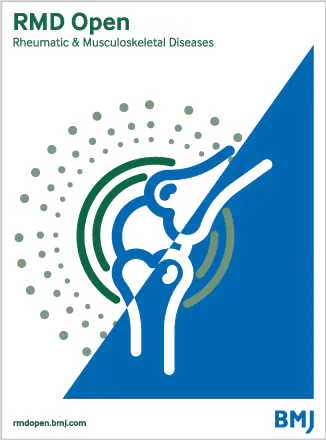高脂饮食会提高胶原蛋白诱发的小鼠关节炎发病率,但不会影响体重
IF 5.1
2区 医学
Q1 RHEUMATOLOGY
引用次数: 0
摘要
肥胖被认为是诱发类风湿性关节炎(RA)的风险因素,肥胖会加重关节畸形1 并降低 RA 患者的生活质量2 。4 在此,我们使用普通饮食和高脂饮食在小鼠中建立了胶原诱导的关节炎(CIA)模型,以观察高脂饮食是否能诱导小鼠出现严重的 RA 症状。CIA小鼠会出现关节炎症状,包括关节肿胀、发红和僵硬,与人类RA的临床特征如出一辙。我们的观察结果表明,与普通饮食组相比,HFD 假组小鼠的体重明显增加,这与之前的报道一致7。本文章由计算机程序翻译,如有差异,请以英文原文为准。
Incidence of collagen-induced arthritis is elevated by a high-fat diet without influencing body weight in mice
Obesity is recognised as a risk factor for triggering rheumatoid arthritis (RA), and it can worsen joint deformities1 and diminish the quality of life in patients with RA.2 The reduction of body weight in obese individuals is believed to alleviate RA symptoms.3 Body mass index (BMI) serves as the primary standard for evaluating obesity.4 An increase in BMI by 1 SD notably elevates the incidence rate of RA, suggesting a causal link between higher BMI and an increased risk of developing RA.5 The association between BMI and obesity is straightforward, as a higher BMI typically indicates a greater risk of obesity.4 Obesity is clinically defined as having a BMI of 30 kg/m2 or greater.4 Here, we established collagen-induced arthritis (CIA) models in mice using both regular and high-fat diets (HFDs) to see if HFD can induce severe RA symptoms in mice. CIA mice develop arthritis symptoms, including joint swelling, redness and stiffness, mirroring the clinical features of human RA.6 Therefore, the CIA model has become the prevailing animal model for RA research. Our observations indicated that mice in the HFD sham group exhibited significantly higher body weights compared with regular diet group, in line with previous reports.7 However, the HFD …
求助全文
通过发布文献求助,成功后即可免费获取论文全文。
去求助
来源期刊

RMD Open
RHEUMATOLOGY-
CiteScore
7.30
自引率
6.50%
发文量
205
审稿时长
14 weeks
期刊介绍:
RMD Open publishes high quality peer-reviewed original research covering the full spectrum of musculoskeletal disorders, rheumatism and connective tissue diseases, including osteoporosis, spine and rehabilitation. Clinical and epidemiological research, basic and translational medicine, interesting clinical cases, and smaller studies that add to the literature are all considered.
 求助内容:
求助内容: 应助结果提醒方式:
应助结果提醒方式:


